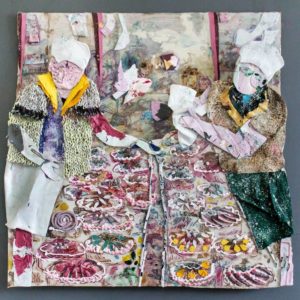One to Watch
 Riin Kaljurand: Pushing the Boundaries of Paint
Riin Kaljurand: Pushing the Boundaries of Paint
Riin Kaljurand investigates the boundaries of subjectivity, particularly through her experience as a woman born in the former Estonian Soviet Socialist Republic, then part of the Soviet Union. Bombarded by advertising, cultural narratives and changing borders, what constitutes our “true self” often evades us, as we unconsciously internalize societal norms. Riin’s sculptural pieces of acrylic and house paint—which she molds and manipulates into “skins” that hang freely without canvases—not only challenge the conventions and expectations of paint, but with their sensual fluidity and permeable borders come to represent embodied subjectivity itself.
Riin holds an MFA (Hons) in painting from the National College of Art and Design in Dublin, Ireland. In 2019, she was recognized as a Saatchi Art Rising Star. She has exhibited her work in Los Angeles, San Francisco, Copenhagen, and Dublin, where she lives and works.
1. Tell us about who you are and what you do. What’s your background?
I first came to Dublin twelve years ago to visit a friend and stayed. I was born in the coastal city of Parnu in Estonia, a country which only gained its independence from the Soviet Union in 1991. In sharp contrast to the sameness of the life I left, Dublin offered more in the way of excitement and opportunity for me as a 25 year-old.
2. What does your work aim to say? What are the major themes you pursue in your work?
My work presents paintings created without the restrictions. I manipulate the paint until it forms a skin, a protective layer, and there are no canvases supporting the paintings. All of the work is about the outcome of experimentation with the materiality of household and acrylic paint – a case of can I?
For example, in my painting “Grass is Always Greener…,” I built the nature-like structure out of dried paint skins that I folded to appear to look as leaves, grass and branches. The impression of a keyboard in “Non-Painting” came from a keyboard that I covered with vaseline and a thick layer of paint, so that I could get the imprint of keyboard. Much of the works are built, scraped, imprinted, knitted because of my personal curiosity, in what paint can and cannot endure. My most recent interest has become focused around paint’s deterioration—when paint dissolves and changes its quality.
3. Can you walk us through your process for creating a work from beginning to end?
4. What series or artistic project are you working on next?
Nina Canell, the Swedish sculptor is one such artist who in her 2011 Treetops, Hillsides and Ditches exhibition uses mastic gum which she allows to drip and ooze over and down four wooden uprights. Like her, I am interested in the idea of expanding the use of materials so that the process too becomes an enduring part of the exhibits.
5. Lastly, why art?
Art has its own merit.
Love reading about all things art? You can have articles from Canvas, curated collections, and stories about emerging artists delivered straight to your inbox. Sign up for the Saatchi Art Newsletter.














